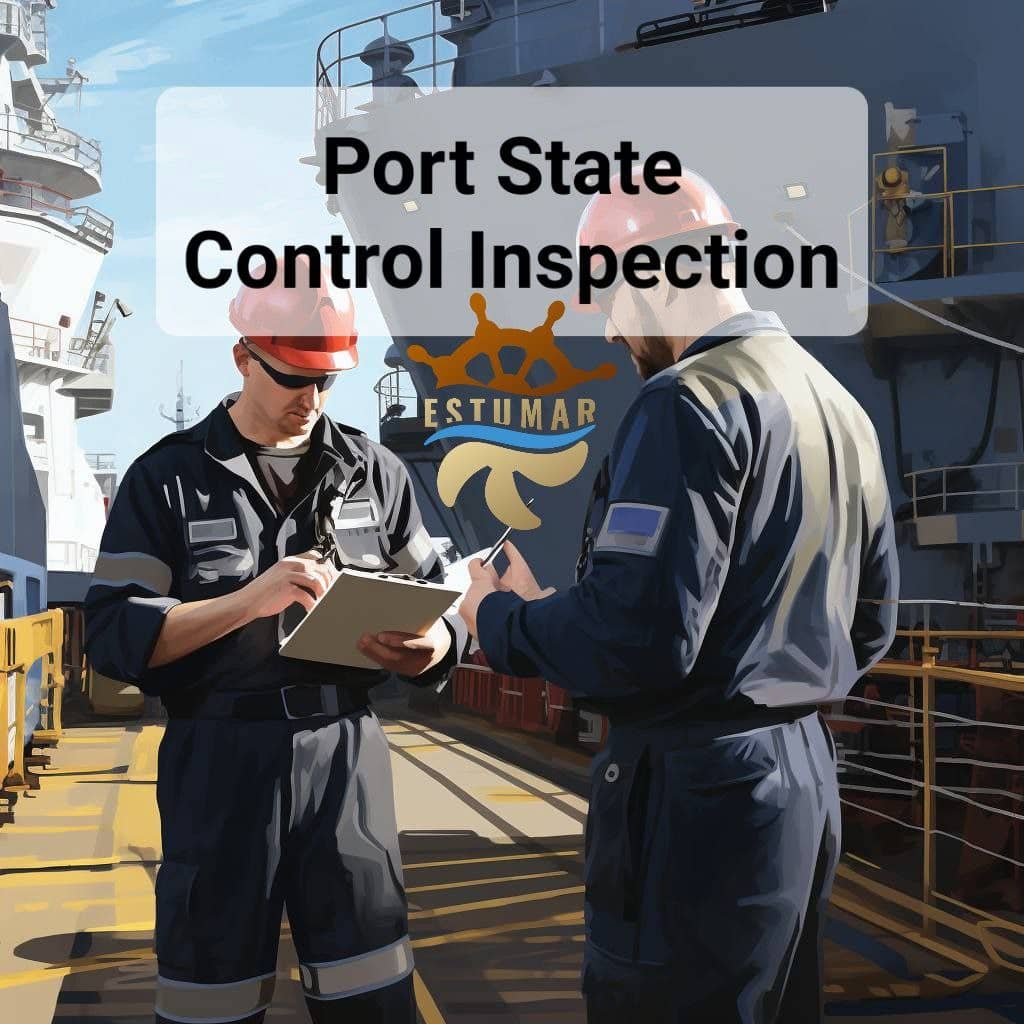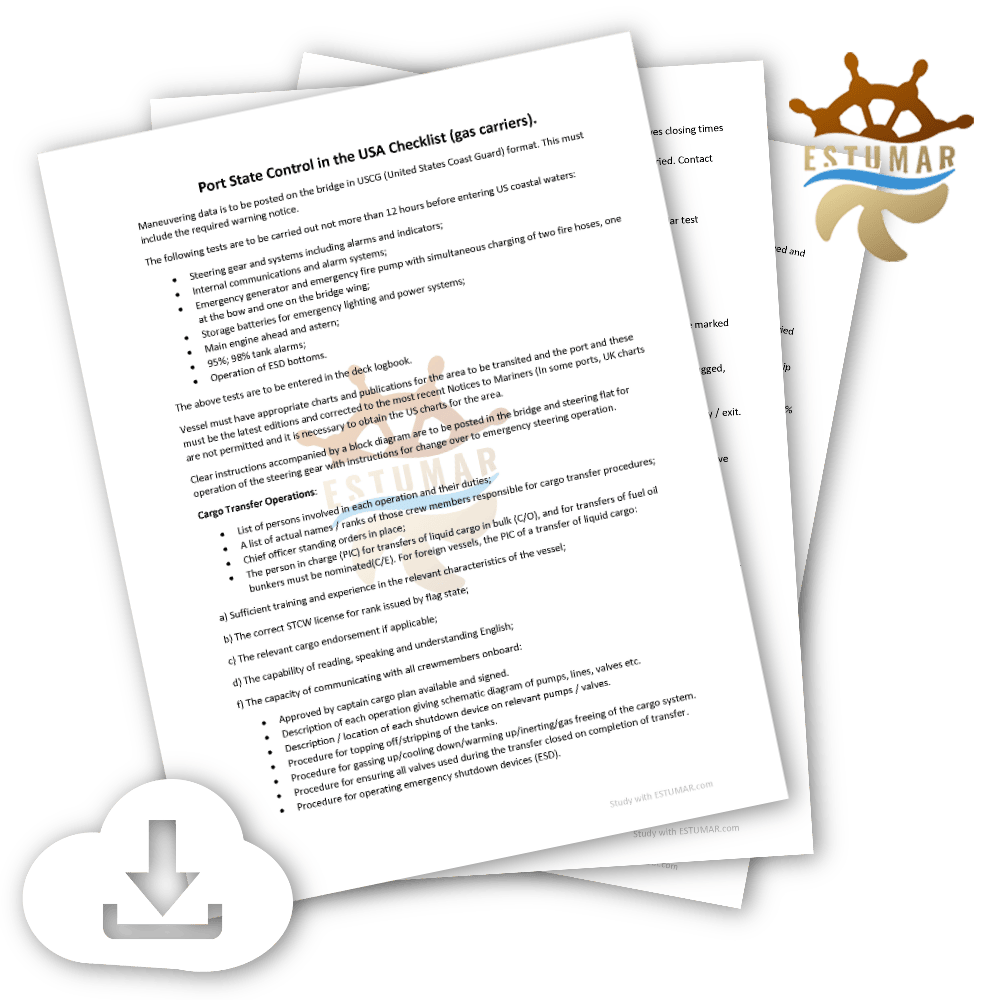
Port State Control (PSC) is the inspection of foreign ships in national ports to verify that the condition of the ship and its equipment comply with the requirements of international regulations and that the ship is manned and operated in compliance with these rules.
Many of IMO's most important technical conventions contain provisions for ships to be inspected when they visit foreign ports to ensure that they meet IMO requirements.
A ship going to a port in one country will normally visit other countries in the region and it can, therefore, be more efficient if inspections can be closely coordinated in order to focus on substandard ships and to avoid multiple inspections.
This ensures that as many ships as possible are inspected but at the same time prevents ships being delayed by unnecessary inspections. The primary responsibility for ships' standards rests with the flag State - but port State control provides a "safety net" to catch substandard ships.
Port State Control in the USA Checklist (gas carriers).
Maneuvering data is to be posted on the bridge in USCG (United States Coast Guard) format. This must include the required warning notice.
The following tests are to be carried out not more than 12 hours before entering US coastal waters:
- Steering gear and systems including alarms and indicators;
- Internal communications and alarm systems;
- Emergency generator and emergency fire pump with simultaneous charging of two fire hoses, one at the bow and one on the bridge wing;
- Storage batteries for emergency lighting and power systems;
- Main engine ahead and astern;
- 95%; 98% tank alarms;
- Operation of ESD bottoms.
The above tests are to be entered in the deck logbook.
Vessel must have appropriate charts and publications for the area to be transited and the port and these must be the latest editions and corrected to the most recent Notices to Mariners (In some ports, UK charts are not permitted and it is necessary to obtain the US charts for the area.
Clear instructions accompanied by a block diagram are to be posted in the bridge and steering flat for operation of the steering gear with instructions for change over to emergency steering operation.
Cargo Transfer Operations:
- List of persons involved in each operation and their duties;
- A list of actual names / ranks of those crew members responsible for cargo transfer procedures;
- Chief officer standing orders in place;
- The person in charge (PIC) for transfers of liquid cargo in bulk (C/O), and for transfers of fuel oil bunkers must be nominated(C/E). For foreign vessels, the PIC of a transfer of liquid cargo:
a) Sufficient training and experience in the relevant characteristics of the vessel;
b) The correct STCW license for rank issued by flag state;
c) The relevant cargo endorsement if applicable;
d) The capability of reading, speaking and understanding English;
f) The capacity of communicating with all crewmembers onboard:
- Approved by captain cargo plan available and signed.
- Description of each operation giving schematic diagram of pumps, lines, valves etc.
- Description / location of each shutdown device on relevant pumps / valves.
- Procedure for topping off/stripping of the tanks.
- Procedure for gassing up/cooling down/warming up/inerting/gas freeing of the cargo system.
- Procedure for ensuring all valves used during the transfer closed on completion of transfer.
- Procedure for operating emergency shutdown devices (ESD).
- ESD system tested and operational. Records of test dates maintained. Manifold valves closing times correct.
- An appropriate Material Safety Data Sheet (MSDS) for each grade of cargo being carried. Contact the office if it is not available onboard.
- Cargo tank dome fittings in good condition. Operating pressures marked.
- MARVS tested. Records of test available.
- Temperature, pressure, level indicators in good condition. Certificates records of regular test available.
- Deck eyewash’s and showers operational and clearly marked.
- High level alarms working and date of last test available.
- Fixed Gas Detection System operating. Calibration records and gas available.
- Deck Spray system tested. Records of test available.
- Cargo pumps tested. Records of test available.
- Cargo pipe lines are to be tested at working pressure and the pressure and test date to be marked clearly on each line (Annual).
- All portable gas measuring equipment calibrated. Records of calibration available.
- All manifold spill trays are fitted with steel plugs and all deck scuppers are mechanically plugged, including poop scuppers.
- Calibrated pressure gauges are fitted to all manifolds.
- Ensure that all accommodation doors remain closed during cargo operations except for entry / exit.
Other records which are required are:
- Safety equipment: check all firefighting equipment has been tested and is valid up to date. Have completed records ready for inspection.
- Oil Record Books, class certificates and the most recent classification society survey report.
- Ballast Water Management Plan and Log and relevant forms.
- Garbage Log and records including receipts of disposed garbage.
The Master is to ensure that all staff are familiar with the requirements of the ISM Code since the U.S.C.G. inspectors may at any time, ask questions regarding the main elements of the code to ensure the vessel’s compliance. Ensure officer’s are aware of who the DPA is and the DPA’s responsibilities. The SOPEP or SMPEP must be approved by Flag State or Classification Society.
All SOLAS certificates must be valid with all annual inspections up-to-date. All Officers must have original licences as required by the Flag State onboard and be all ready for inspection. All officers and crew, as applicable, must have required special qualifications, e.g. dangerous cargo endorsements, hazmat, specific ECDIS training certificates etc.
Working hours pre-plan for all persons onboard has been prepared which complies with the Code of Federal Regulations governing working hour limitation. Records of working hours shall be available for inspection.
In addition to the above, we bring to your attention the following:
- Make up procedure for enclosed entry procedure and post in prominent positions;
- Ensure that all port and Company smoking regulations are in place;
- Ensure all trading and type approved certificates are valid and ready for inspection;
- Ensure that portable gas detectors are available for all watchkeepers;
- Ensure that all officers are immediately identifiable to shore personnel;
- That all alcohol is forbidden, REPEAT FORBIDDEN, in US waters. All alcohol is to be removed and placed under lock and key;
- Place warning signs. (No visitors / unauthorised personnel / no smoking);
- Sewage unit (MSD) or tank functioning correctly and certificate available;
- Ensure that no hotwork is carried out.
Garbage management must strictly be in compliance with Company regulations. Large fines can be levied for incorrect storage and disposal of garbage and in particular plastics.
Be aware that the USCG inspectors are carrying out strict emergency drills, fire drills and full abandon ship drills and are picking crew members at random to start emergency fire pump, emergency generator and lifeboat engines. They will require one boat to be lowered into the water if safe and practical. The drills must be carried out promptly and in a satisfactory manner. Unsatisfactory drills account for in excess of 25% of detentions.
Ships with major deficiencies can be detained.
Port state control officers may impose a detention on ships with major deficiencies, it means that the ship couldn't leave the port of inspection. A ship is detained when it is unfit to proceed to sea or the deficiencies pose an unreasonable risk to the ship, its crew or the environment.
The ship is kept under detention until the rectification of all deficiencies has been verified by a port state control officer by means of a re-inspection.
- Tags:
- Competence

Comments